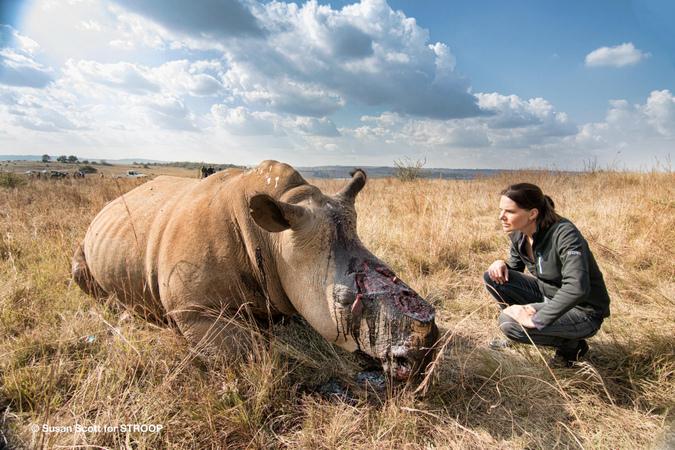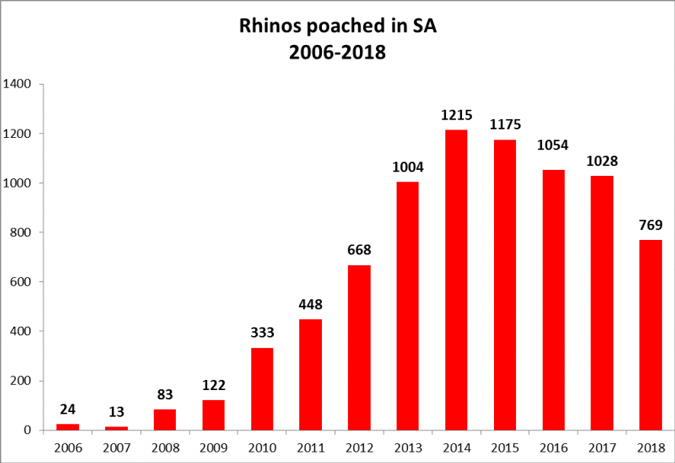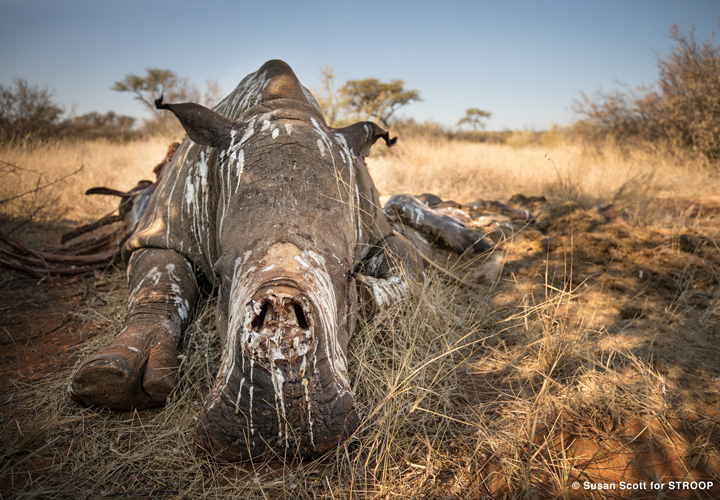
Sourced from third-party site: Department of Environmental Affairs
The latest annual rhino poaching statistics have been released by the Department of Environmental Affairs. Minister of Environmental Affairs, Ms Nomvula Mokonyane, has reported significant progress on the implementation of the Integrated Strategic Management of Rhinoceros covering the period 1 January to 31 December 2018. But Susan Scott (STROOP – Journey into the Rhino War filmmaker) cautions against too much optimism.
The statistics show that in 2018 there was a decrease in rhino poaching incidents to 769, making it the third consecutive year that South Africa has seen a decline in rhino poaching, particularly in the national parks. This is a decrease of 259 rhino compared to 2017 (1,028 rhino poached). It is also the first time in five years that the annual figure is under 1,000.

A total of 421 rhino were poached in the Kruger National Park, 16.5% less than the 504 poached in 2017, and one was poached at the Marakele National Park.
The number of poacher activities in the Kruger National Park declined by only two recorded activities during the year, with a total of 2,620 incursions and 125 contacts recorded during 2018.
The provincial and national breakdown for rhino poaching incidents in 2018 is as follows:
| PROVINCES AND NATIONAL PARKS | 2017 | 2018 |
| SANParks | 504 | 422 |
| Gauteng | 4 | 2 |
| Limpopo | 79 | 40 |
| Mpumalanga | 49 | 51 |
| North West | 96 | 65 |
| Eastern Cape | 12 | 19 |
| Free State | 38 | 16 |
| Northern Cape | 24 | 12 |
| Kwa-Zulu Natal | 222 | 142 |
| Western Cape | 0 | 0 |
| Total | 1028 | 769 |
With regard to the biological management of rhinos, the statement mentioned that “within Kruger National Park, the translocation of rhinos from Kruger as part of South Africa’s biological management innovations of expanding ranges and establishing additional rhino strongholds are challenged by the emergence of bovine tuberculosis in both black and white rhino, albeit at low incidence … the development of efficient systems to overcome this challenge is in progress”.
It continues, saying: “Even so, innovative biological management have used translocations within Kruger National Park as a mechanism to direct poaching to focus less on cows. This goes hand in hand with initiatives to dehorn rhinos embedded in strategic approaches that target individuals that frequent poaching hotspots, but more importantly, approaches that minimise the losses of cows. Complimenting these interventions are guarding initiatives that focus on regular individual monitoring of individual rhinos. These combinations of interventions seek to ensure maximising the breeding potential of both black and white rhinos.
“The integrated initiatives of SANParks to manage its rhino population have had varied successes. Within Kruger National Park the continued onslaught of poaching resulted in a continued decline of rhinos. SANParks conducted a distribution survey of rhinos that forms part of predicting future rhino localities that can inform pro-active anti-poaching and biological management. This also allowed the evaluation of the robustness of the techniques to obtain formal rhino estimates. The evaluation is in progress.”
The statement concludes saying, “Combating rhino poaching remains a national priority, and as such, all the relevant government departments will continue their close collaboration to ensure that this iconic species is conserved for generations to come. Although we are encouraged by the national poaching figures for 2018, it is critical that we continue to implement collaborative initiatives to address the scourge of rhino poaching.”
Filmmakers Susan Scott and Bonné de Bod – the makers of the award-winning rhino documentary STROOP: Journey into the Rhino Horn War – had the following to say regarding the latest rhino poaching statistics:
Of course it’s welcome news that we’re under 1,000 rhinos poached for the first time in five years, but if we look deeply into the release coming from the department, there are some grim facts that we need to look at, and we must look at what’s not in the release:
1. Poaching numbers
The stats are broken down by province, so it’s hard to see the state rhino stats versus the privately owned rhino poaching stats. And that would tell us a lot… we know that farmers have sold their rhinos, exporting them overseas or moving them to neighbouring range states while our state rhinos, those in Kruger in particular, are down in total numbers so there are fewer rhinos to poach**.
And we can look at the incursion stats that were also released, they are staying at around the same rate: 2,620 last year compared to 2,662 the previous year (1% decrease). So the onslaught is not stopping. We’re still at seven incursions a day. That’s not the amount of people… that’s the incursions… footprints seen in the park, sound picked up, rangers spotting poaching teams. So seven times a day a gang is active inside Kruger and those are the picked up incursions.
The onslaught is not subsiding and the loss of Ranger Respect Mathebule last year has also changed things for the ranger corps.
2. Tuberculosis (TB)
We’ve seen papers out on the TB inside the Kruger National Park from 2016* and Karen Trendler will tell you that that is because our rhinos are under severe stress from the poaching, and the drought of 2016/17 no doubt played a huge role. This is the first time the department has mentioned that our Kruger rhinos (black and white) have TB, although they say “albeit at low incidence”. They go on to say that South Africa’s veterinary regulations are strict about preventing TB from being spread into commercial stock, so they are developing systems for this challenge… this does mean that auctions are on hold, which also tells us the severity of this. And there is no mention if orphans rescued in the Kruger also have TB which will affect any protocols in place for that.
3. Recognition of collateral damage
The release goes on to say that translocations have happened within the park as a way to reduce poaching on cows. It’s very unclear from the language used, but it also seems that Kruger are dehorning cows in poaching hotspots. The actual quote is: “This goes hand in hand with initiatives to dehorn rhinos embedded in strategic approaches that target individuals that frequent poaching hotspots, but more importantly, approaches that minimise the losses of cows.”
This is a biggie. For years now there hasn’t been acknowledgement of this collateral damage where rhinos breed well, but cows poached not only removes that individual from the population but all future rhinos that could’ve been birthed by her and that could be as much as anywhere from 10 to 15 rhinos in her lifetime. This collateral damage is a real worry in this poaching crisis.
We’re a long way from it, but once rhinos get below a certain number in the wild, they become less productive, and can even become infertile which we’ve witnessed with the northern white rhinos, and isolated populations of the Javan and the Sumatran rhinos. Plus, have’t we always been told that rhinos in Kruger can’t be dehorned because they cannot defend themselves from lions and each other? We’ve all heard many stories of female cows protecting their young with their horns. This needs to be looked into more deeply.

4. Census of Kruger rhinos
The worldwide management of rhinos depends hugely on numbers coming out of Kruger. The poaching deaths yes, but more importantly the living numbers of wild rhinos in the world’s largest population, which of course is Kruger’s white rhino population. We have CITES in Sri Lanka in a few months time and this is the body that actually sets the agenda for rhino management for the next three years (they only meet once every three years).
So trading in rhino horn internationally will be decided at CITES and exporting live rhinos to Asia will be determined by what happens at CITES. So it’s very important that we know what the largest population of rhinos on the planet is…
Block-counting was the method used up until the last census, (Aug/Sept 2017). And the census results are usually released a few months after they are compiled but not this last one… it was released a year later, a day before World Rhino Day in September last year. We were in San Francisco for the world premier of STROOP and we were 10,000 miles away but still surprised that the press didn’t pick up on it.
White rhino numbers had declined by almost 30%. Thirty percent! Let’s look at this: the 2017 number was given as a range from 5,532 to 4,759 versus the previous census count in 2016 where the range was 7,830 to 6,649 and when that was released, Africa Geographic was the only publication to note that it was an 18% decline**.
I asked a DEA spokesperson why the most recent census results, the 2018 ones, had not been released yesterday and was told to get them from SANParks… we’ve been on this roundabout before. SANParks can’t release them to us, they release them to the department who then release them to the public. So this latest press release should’ve had the 2018 rhino numbers from the last Kruger census in 2018, but they’re not there. There have been a lot of rumours about “real” rhino numbers and if the block counting method of extrapolation is flawed leaving us all with the worry that the number is much lower than the range of around 5,000 counted back in 2017.
But the bigger picture that we must focus on is if we go back to the start of the poaching crisis… to 2010. The range of white rhinos counted in the park was 12,700 to 8,700***. In seven years, anthropomorphic factors (poaching and a little bit of the drought) have caused a 56 to 47% drop in our white rhino numbers in the Kruger. Half of our population is gone. Half. And we were told not to worry, rhinos breed well.
The next CITES is coming up and when the diplomats sit down in the huge conference halls to read through papers of white rhino management, our white rhino stats from 2017 will be a year and a half old, that’s what should’ve been in the press release coming out of the department today/yesterday. No wonder animals get uplisted at CITES when it’s almost too late… they’re working on old data. It’s the number that’s not in the press release that’s most important for our rhinos… how many are left, not just in Kruger but in the whole country.
In conclusion
The takeaway is to press the department for as much information as possible to help those in decision making processes… such as the correct and latest census results of Kruger’s rhinos. And the incursions are not stopping. Financial support has declined for Kruger and the worry is that it will decline further when South Africans see that rhinos poaching numbers have declined. Our rangers in Kruger, iMfolozi, and all our state parks need even more support now, we cannot take our eye off this.
Since the crisis started in 2010 we can now, by official numbers, say that we have lost at least half our white rhino population in the Kruger National Park, and that’s despite an incredible effort by the ranger corps. Now, more than ever, we should be ploughing in whatever support we can give them. The fight is a long way from over.
* Mycobacterium bovis in a Free-Ranging Black Rhinoceros, Kruger National Park, South Africa, 2016: https://www.researchgate.net/publication/314145118_Mycobacterium_bovis_in_a_Free-Ranging_Black_Rhinoceros_Kruger_National_Park_South_Africa_2016
** 18% crash in Kruger white rhino population: https://africageographic.com/blog/crash-in-kruger-white-rhino-population/
*** SANParks annual report 2011: https://www.sanparks.org/assets/docs/general/annual-report-2011.pdf, and Status of Rhino Population in Kruger: https://www.environment.gov.za/sites/default/files/docs/rhinopopulationstatus_august2014.pdf
To comment on this story: Login (or sign up) to our app here - it's a troll-free safe place 🙂.![]()






